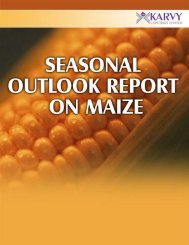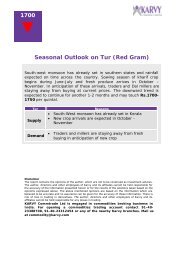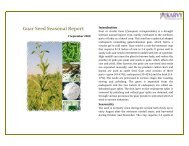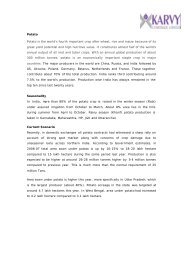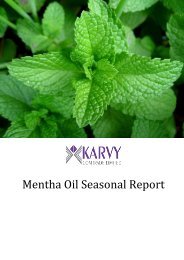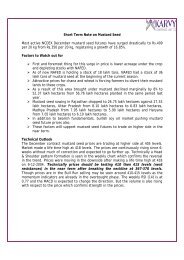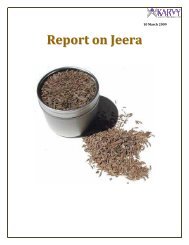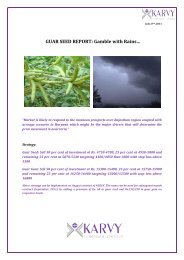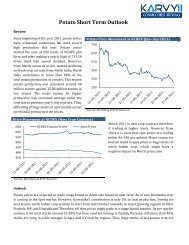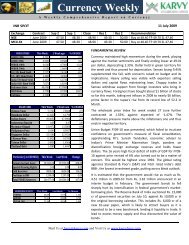A seasonal report on Maize - Karvy Commodities Broking
A seasonal report on Maize - Karvy Commodities Broking
A seasonal report on Maize - Karvy Commodities Broking
Create successful ePaper yourself
Turn your PDF publications into a flip-book with our unique Google optimized e-Paper software.
According to USDA, producti<strong>on</strong> & c<strong>on</strong>sumpti<strong>on</strong> for year 2012-13 is expected to increase by 9% and 6%respectively, hence adequate supplies will be there for exports. Therefore, lower imports and higherexports are projected for 2012-13. However, 6% of crop got damaged due to La Nina.Major Importers & Exporters of <strong>Maize</strong> in WorldThe largest maize importer in World is Japan followed Mexico, South Korea followed by EU-27, China.European Uni<strong>on</strong> can import from United States since enough supplies are projected.United States is the largest maize exporter in world followed by Argentina, Ukraine and Brazil. Thedestinati<strong>on</strong> for exports are slightly different compared to the previous years. India and Ukraine has acompetitive advantage in maize exports to China due to lower prices as compared to US and good supplies.As per the 2011-12 estimates, the top exporters of <strong>Maize</strong> in the world are United States (South America),Argentina, Ukraine and Brazil. The major countries that import maize are Japan, Mexico, South Korea andChina but by the end of the year 2014, China is expected to become the top importer of maize in the worlddue to the c<strong>on</strong>tinuously increasing demand from the feed industry which is more than 61% of the totaldemand.Major <strong>Maize</strong> ImportersMajor <strong>Maize</strong> ExportersOther41%China Egypt5% 5% EU-276%Iran4%Japan16%Others11%Argentina15%Brazil13%EU-273%Taiwan5%Mexico10%Korea,South8%UnitedStates41%Ukraine14%India3%Source: USDA & KCTL Research<strong>Maize</strong> Balance Sheet- CHINATotal Supply (Milli<strong>on</strong> T<strong>on</strong>s)Total Demand (Milli<strong>on</strong> T<strong>on</strong>s)Years BeginningstocksImports Producti<strong>on</strong> Exports C<strong>on</strong>sumpti<strong>on</strong> Endingstocks2011-12 49.415 5 192.780 0.2 188.000 58.9952012-13* 58.995 7 195.000 0.2 201.000 59.795Source: USDA estimates (* projected)As per USDA estimates, producti<strong>on</strong> is expected to increase by 1% and c<strong>on</strong>sumpti<strong>on</strong> by 7%. This widemismatch between the demand and supply will arise due to the ever increasing populati<strong>on</strong>, increasing percapita meat c<strong>on</strong>sumpti<strong>on</strong> and hence feed demand apart from industrial demand for starch, corn syrup andother processed products. Producti<strong>on</strong> is stagnant; productivity is not increasing compared to the area. Eventhough the beginning stocks are more by 19%, it is expected that the demand will not match with thesupply due to increasing c<strong>on</strong>sumpti<strong>on</strong>. In the 2010 crop year, around 70 t<strong>on</strong>s of every 100 t<strong>on</strong>s of cornused in China were used for feed. China’s Corn producti<strong>on</strong> in 2010 decreased by 13% to a four year lowdue to drought and hence China became an importer of corn from 2010 from being an exporter. Cornimports are taking place apart from soybean imports. For the first time, China has started importing cornfrom Ukraine due to lower cost than US and it is n<strong>on</strong> genetically modified crop. So, Chinese firms are able toprocure the raw materials in abundance at cheaper rates to fulfil all their demands. While, imports areexpected to increase by 40% Y/Y. Previously, it was dependent <strong>on</strong> United States entirely for its supply. But




